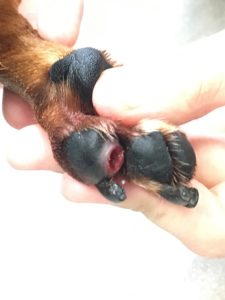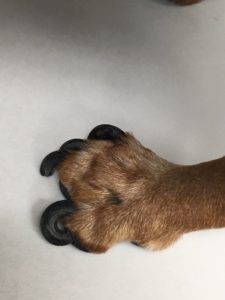Torn nails in cats and dogs are a painful problem that can lead to bleeding and infection. Fortunately, taking care of your pet’s nails at home can minimize the risk of injury.
Causes of Torn Nails
Your pet’s nails can snag and tear if they are not trimmed often enough. Nails can become snagged on carpets, furniture, and bedding inside the home. Pets may also tear their nails on rocks or vegetation when playing outside. Other risk factors for torn nails include weakened nails caused by underlying health conditions and improper trimming of nails.
Symptoms of Torn Nails
Your pet’s nail is composed of two main parts; the quick and the outer nail. The quick consists of living tissue that contains nerves and blood vessels. The outer nail is made of a hard substance called keratin that protects the quick. When a nail is torn, the sensitive quick can become damaged and exposed leading to extreme pain and bleeding.
A hanging nail and exposed quick is the most obvious symptom of a torn nail. Other signs include bleeding, inflammation, and swelling. You may also notice that your pet is limping or compulsively licking the site of the injury.
What to Do If Your Pet Has a Torn Nail
We recommend visiting your veterinarian if your pet has a torn nail to minimize the risk of infection. It may be possible to stem the bleeding and wrap your pet’s paw before making an appointment, but please be aware that pets can become anxious or aggressive when in pain.
Treatment of Torn Nails
Your veterinarian will examine your pet’s nail and remove any damaged portions. They will also clean and disinfect the site of the injury. The paw will usually be bandaged to protect the wound while it heals. Pain relief medication and antibiotics may be prescribed to treat pain and prevent an infection from developing.
Preventing Torn Nails
The best way to prevent torn nails is to keep your pet’s nails trimmed. Many pet owners choose to trim their pet’s nails at home. If you are uncomfortable doing this, speak to your veterinarian about scheduling regular appointments to have your pet’s nails trimmed.
Tips for Trimming Your Pet’s Nails
When cutting your pet’s nails, make sure to only trim the tips so the quick is left undamaged. A dog’s nails should be trimmed as soon as they become long enough to touch the ground when walking. The sharp ends of a cat’s nails should be trimmed regularly, around once every two weeks is suitable for most cats.
Before trimming your pet’s nails for the first time, allow them to get used to having their paws touched. Many pet owners find it helpful to start slowly and trim just one nail on the first attempt. It’s also a good idea to reward your pet when they have their nails trimmed by praising them or giving treats.
Please ask your veterinarian if you need more guidance. They will be happy to give you a demonstration so you can safely trim your pet’s nails at home.



